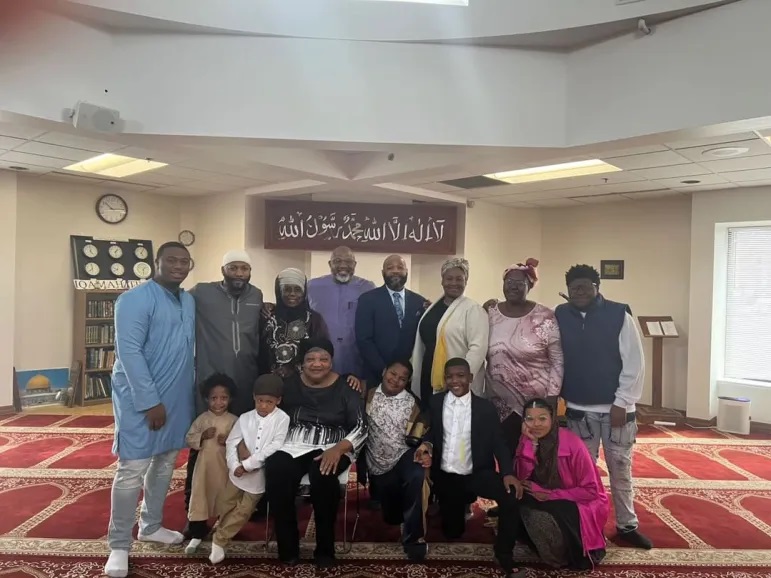Binta Kanteh , Minneapolis Spokesman-Recorder
The day is near, and its excitement is palpable. After 30 days of fasting from dawn to sunset and intentional commitment to spiritual and character improvement, Muslims worldwide will close the month of Ramadan with the celebration of Eid Al-Fitr.
Following the brief morning prayer, many people will go to brunch or return home for a nap. From there, Muslims will likely spend the day with others in celebration with lots of laughter and food. But before all the festivities begin, even before the morning prayer, Muslims wake up eager on a particular day, ready to sport an outfit or two they’ll be wearing.
Eid Day is a geography, history, and culture masterclass through clothing. According to the University of Minnesota Extension, there are around 150,000 Muslims in Minnesota. From that population, a large cohort are of the Black Diaspora.
From my earliest memories of Eid through the present day, I have never failed to be in awe and fascination with the vast backgrounds of Muslims within the Black diaspora. Much of that admiration is experienced through what our eyes can see and the adornment we can touch, all in the colorful and magnificently structured garments.
Leading up to Eid Al-Fitr this year, I interviewed a few people who shared their experience dressing their best for Eid and why it is essential for them to do so. Their perspectives might highlight some context behind the Eid day styles you’ll come across at the mosques, restaurants, malls, and your social media timelines.
“This is an opportunity for us to show people where we came from,” Mariamu Jagana asserted. “You’ll be surprised about how many different cultures are out there and how different ways people dress up.”
A Gambian Minnesotan, Jagana prides herself on consistently dressing to the nines for every Eid. For her, the occasion carries serious weight and is a time to reflect on the blessing of being alive to observe another holiday.
“There are people who have died [since the last Eid] that would’ve wanted to spend another Eid with their families. You deserve to celebrate. What are you doing if you are not showing up and showing out? I love how we come together; we are all one,” she said.
Ismael Kamara, a Minnesotan whose cultural roots stem from Guinea and Sierra Leone, shared a similar appreciation for the significance of how we adorn ourselves for Eid and the sense of community style cultivates.

“As a kid, I was never thrilled to wake up early, but I was thrilled to experience Eid,” he said.“As an adult now, I’m putting the pieces together. It’s very moving. It shows how much religion and culture can bring people together.”
The energy and intention that drive Eid day style aren’t only prompted by Muslims’ high spirits. The encouragement to dress for celebrations like Eid is also exemplified in the Hadiths (authentic narrations) of the Prophet Muhammad (Peace Be Upon Him).
“The Prophet Muhammad (pbuh)* was known to have a special garment he would wear for the two Eid [holidays] and on every Friday. He would wear the best of his clothes on Eid,” Kaltun Karani stated. Karani, who is of Somali origin and a mental health therapist, teacher, and writer in Minnesota, explained the connection between how many Muslims choose to dress up for Eid and examples of how one should show up in society through clothing, as referenced in the Islamic texts.
“The text says to wear the best of your clothes. To wear the best doesn’t necessarily mean new,” she said. Karani shared her hopes of what the broader non-Muslim population in Minnesota can take away from the Eid celebrations: “I hope it shows the humanity of Muslims and how committed they are to their faith.”
Shortly before one of his daily virtual Ramadan evening sermons, Makram El-Amin, resident Imam of Masjid An-Nur in Minneapolis, emphasized the importance of dressing well in Islamic texts, especially at the mosque, and added, “[Eid] is different. This is the time to show up and show out a little.”
Imam El-Amin’s jubilance, when discussing incorporating culture in worship shined. “Whatever our cultural tradition is, the best of our cultures should be displayed on Eid day.”
Jamillia Bryant, whose family history in the United States spans several generations, says that she incorporates her culture into how she expresses herself in the Islamic context in a comfortable way. She learned from her elders, such as her mom, aunts, and cousins, how to go about her style.
Growing up, the hectic air of Eid morning in a big household was an undertaking, but it marked the beginning of an important day. “When I had a dress that made me feel good, I was celebratory for myself and my family,” she said. As a current design student, Bryant expressed that on Eid “I’m so hungry to see everything. I love it all.”
*(pbuh) means Peace Be Upon Him, a salutation that Muslims add to the Prophet Muhammad’s name whenever said.
Eid Al-Fitr is expected to occur on Wednesday, April 10, depending on the sighting of the crescent moon.

